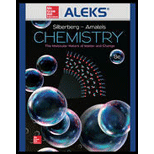
Concept explainers
(a)
Interpretation:
The condensed ground state electronic configuration of
Concept introduction:
The electronic configuration of an element tells about the distribution of electrons in the atomic orbitals. It is used to predict the physical, chemical, electrical and magnetic properties of the substance.
Paramagnetism is a form of magnetism where the materials are weakly attracted by an externally applied magnetic field. It is due to the presence of unpaired electrons in the materials so all the atoms with incompletely filled atomic orbital are paramagnetic.
The intensity of paramagnetism increases with the increase in the number of unpaired electrons. Due to their spin, the unpaired electrons have a magnetic dipole moment and act like tiny magnets.
(b)
Interpretation:
The condensed ground state electronic configuration of
Concept introduction:
The electronic configuration of an element tells about the distribution of electrons in the atomic orbitals. It is used to predict the physical, chemical, electrical and magnetic properties of the substance.
Paramagnetism is a form of magnetism where the materials are weakly attracted by an externally applied magnetic field. It is due to the presence of unpaired electrons in the materials so all the atoms with incompletely filled atomic orbital are paramagnetic.
The intensity of paramagnetism increases with the increase in the number of unpaired electrons. Due to their spin, the unpaired electrons have a magnetic dipole moment and act like tiny magnets.
(c)
Interpretation:
The condensed ground state electronic configuration of
Concept introduction:
The electronic configuration of an element tells about the distribution of electrons in the atomic orbitals. It is used to predict the physical, chemical, electrical and magnetic properties of the substance.
Paramagnetism is a form of magnetism where the materials are weakly attracted by an externally applied magnetic field. It is due to the presence of unpaired electrons in the materials so all the atoms with incompletely filled atomic orbital are paramagnetic.
The intensity of paramagnetism increases with the increase in the number of unpaired electrons. Due to their spin, the unpaired electrons have a magnetic dipole moment and act like tiny magnets.
(d)
Interpretation:
The condensed ground state electronic configuration of
Concept introduction:
The electronic configuration of an element tells about the distribution of electrons in the atomic orbitals. It is used to predict the physical, chemical, electrical and magnetic properties of the substance.
Paramagnetism is a form of magnetism where the materials are weakly attracted by an externally applied magnetic field. It is due to the presence of unpaired electrons in the materials so all the atoms with incompletely filled atomic orbital are paramagnetic.
The intensity of paramagnetism increases with the increase in the number of unpaired electrons. Due to their spin, the unpaired electrons have a magnetic dipole moment and act like tiny magnets.
Want to see the full answer?
Check out a sample textbook solution
Chapter 8 Solutions
CHEMISTRY:MOLECULAR NATURE...-ALEKS 360
- At an electrified interface according to the Gouy-Chapman model, what types of interactions do NOT occur between the ions and the solvent according to this theory?arrow_forwardPlease predict the products for each of the following reactions. Clearly show the regiochemistry (Markovnikov vs anti-Markovnikov) and stereochemistry (syn- vs anti- or both). If a mixture of enantiomers is formed, please draw all the enantiomers. Hint: In this case you must choose the best answer to demonstrate the stereochemistry of H2 addition. 1.03 2. (CH3)2S BIZ CH₂OH 2. DMS KMnO4, NaOH ΖΗ Pd or Pt (catalyst) HBr 20 1 HBr ROOR (peroxide) HO H-SO HC 12 11 10 BH, THE 2. H2O2, NaOH Brz cold HI 19 18 17 16 MCPBA 15 14 13 A Br H₂O BH3⚫THF Brz EtOH Pd or Ni (catalyst) D₂ (deuterium) 1. Os04 2. H2O2 CH3CO3H (peroxyacid) 1. MCPBA 2. H₂O* H B + H H H "H C H H Darrow_forwardExplain how Beer’s Law can be used to determine the concentration in a selected food sample. Provide examples.arrow_forward
- Explain the importance of having a sampling plan with respect to food analysis. Explain the importance of having a sampling plan with respect to food analysis. Provide examples.arrow_forwardPlease predict the products for each of the following reactions. Clearly show the regiochemistry (Markovnikov vs anti-Markovnikov) and stereochemistry (syn- vs anti- or both). If a mixture of enantiomers is formed, please draw all the enantiomers. cold KMnO4, NaOH 2. DMS 1. 03 CH3OH Br2 1. 03 2. (CH3)2S H₂ Pd or Pt (catalyst) HBr 18 19 20 1 HBr ROOR (peroxide) H₂O H₂SO4 HCI HI 17 16 6 15 MCPBA 1. BH3 THF 2. H₂O2, NaOH 1. OsO4 2. H₂O₂ 110 CH3CO₂H (peroxyacid) 1. MCPBA 2. H₂O* Br2 H₂O BH3 THF B12 EtOH Pd or Ni (catalyst) D₂ (deuterium) Bra A B C D H OH H OH OH H OH α α α OH H OH OH фон d H "Harrow_forwardBriefly indicate the models that describe the structure of the interface: Helmholtz-Perrin, Gouy-Chapman, Stern and Grahame models.arrow_forward
 ChemistryChemistryISBN:9781305957404Author:Steven S. Zumdahl, Susan A. Zumdahl, Donald J. DeCostePublisher:Cengage Learning
ChemistryChemistryISBN:9781305957404Author:Steven S. Zumdahl, Susan A. Zumdahl, Donald J. DeCostePublisher:Cengage Learning ChemistryChemistryISBN:9781259911156Author:Raymond Chang Dr., Jason Overby ProfessorPublisher:McGraw-Hill Education
ChemistryChemistryISBN:9781259911156Author:Raymond Chang Dr., Jason Overby ProfessorPublisher:McGraw-Hill Education Principles of Instrumental AnalysisChemistryISBN:9781305577213Author:Douglas A. Skoog, F. James Holler, Stanley R. CrouchPublisher:Cengage Learning
Principles of Instrumental AnalysisChemistryISBN:9781305577213Author:Douglas A. Skoog, F. James Holler, Stanley R. CrouchPublisher:Cengage Learning Organic ChemistryChemistryISBN:9780078021558Author:Janice Gorzynski Smith Dr.Publisher:McGraw-Hill Education
Organic ChemistryChemistryISBN:9780078021558Author:Janice Gorzynski Smith Dr.Publisher:McGraw-Hill Education Chemistry: Principles and ReactionsChemistryISBN:9781305079373Author:William L. Masterton, Cecile N. HurleyPublisher:Cengage Learning
Chemistry: Principles and ReactionsChemistryISBN:9781305079373Author:William L. Masterton, Cecile N. HurleyPublisher:Cengage Learning Elementary Principles of Chemical Processes, Bind...ChemistryISBN:9781118431221Author:Richard M. Felder, Ronald W. Rousseau, Lisa G. BullardPublisher:WILEY
Elementary Principles of Chemical Processes, Bind...ChemistryISBN:9781118431221Author:Richard M. Felder, Ronald W. Rousseau, Lisa G. BullardPublisher:WILEY





